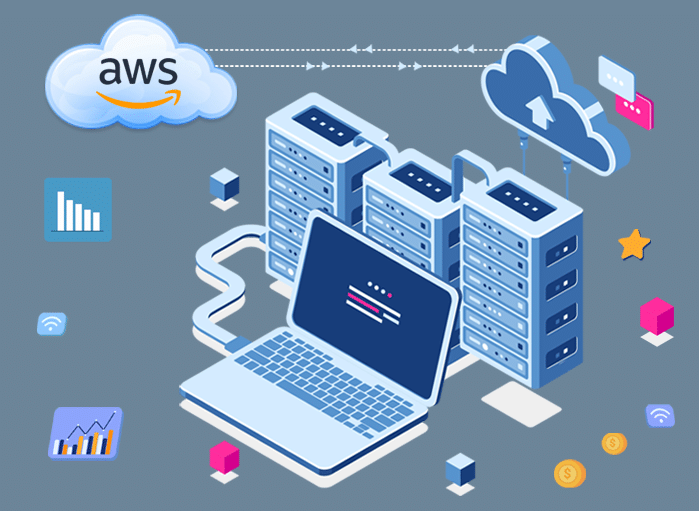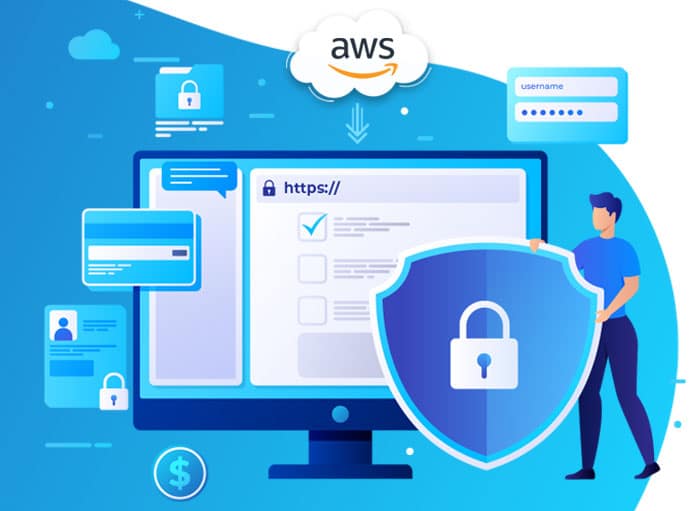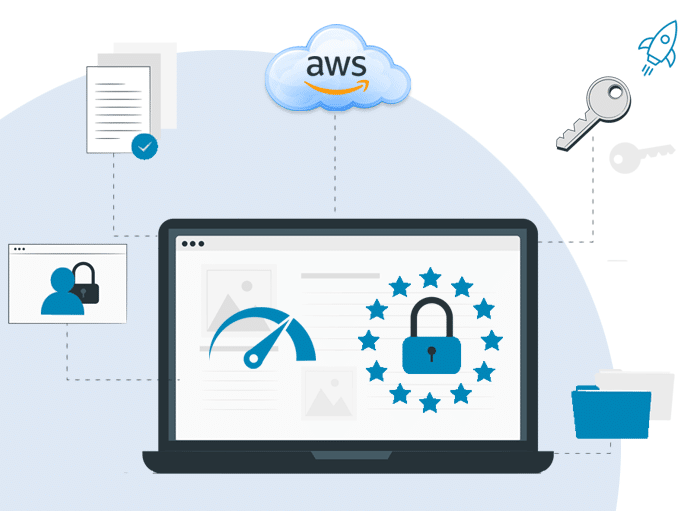Do you want to stay updated about the public cloud computing landscape? Are you fascinated to see the changes that are brought to the public cloud infrastructure? If yes, then you are on the right blog post. We all know that AWS re: Invent 2022 saw many announcements. Among several announcements, one news that might pique the interest of the government sector is the launch of the AWS Continuity of Government IT (CGIT) program. To support the IT governance framework, this program is helpful.
Government Sectors Are Using AWS
It’s true that the government sector relies on Amazon Web Services for meeting its mission and requirements. Since AWS is known for its high level of security, compliance, and reliability, it is regarded as one of the top cloud computing platforms.
With AWS government IT solutions, government bodies don’t need to worry about the security, and reliability of the cloud. They simply support the IT infrastructure to such an extent that one doesn’t need to worry about anything.
Government agencies that face any kind of cloud computing challenge can easily adapt to cloud computing. It is known that AWS offers cloud capabilities across different classification levels, such as Unclassified, Secret, Sensitive, and Top Secret.
As we move toward normalcy, organizations need to adopt, as well as innovate to keep up with the constantly evolving global landscape. This, in turn, will help to meet the needs of the customers.
Understanding of AWS as a Solution to IT Governance Framework
New to AWS? Then you might not know AWS is a great alternative to government IT solutions.
Yes, you heard that right. No matter whether government agencies or authorities need a robust IT infrastructure, then they can rely on AWS. The framework offered by AWS is not only strong but reliable and secure.
Often, it has been seen that government bodies use distinct types of AWS services, such as AWS Virtual Private Cloud, AWS GovCloud (US), AWS Elastic Compute Cloud (Amazon EC2), and many more services to ensure security and compliance and satisfy the security demands.
For instance, through AWS GovCloud (US), government customers and their partners get the flexibility to design a secured cloud solution that adheres completely to the U.S. Government compliance regulations.
Usually, the AWS Cloud maintains compliance with the Health Insurance Portability and Accountability Act (HIPAA), FedRAMP, Family Educational Rights and Privacy Act (FERPA), and Criminal Justice Information Services (CJIS).
In fact, AWS services can help the government sector in many ways. One such way that AWS is helping the government is through various programs. One such program is the Continuity of Government IT (CGIT) program.
AWS starts Continuity of Government IT (CGIT) Program
You might not be aware of the CGIT program. However, you don’t need to freak out as we will provide some insight into this program.
With this program, protecting digital assets will become easy for the government. Additionally, it will help to protect their services from interruptions or interference.
This solution guide is designed to help governments maintain the integrity of critical data sets, reduce the risk of compromising the continuity of operations, and many more things.
Basically, this program can be a great support to the existing IT governance framework of the government bodies.
Government Can Transform Services Securely in the Cloud
Public sector organizations have a common concern. The concern is related to ensuring digital transformation while maintaining data security. It is true that security is often a digital transformation enabler; at the same time, sometimes it is an accelerator for government agencies.
Well, it helps them to support their existing IT governance framework. In fact, government bodies maintain consistency of their operations, they shift their existing IT infrastructure to the cloud. This helps them to have complete peace of mind.
1. Things to Keep in Mind
When governments start their digital transformation in the cloud, still they ponder about security in terms of IT modalities. The applicable legacy approach helps to push towards a bespoke IT solution. As a matter of fact, this will impede the service delivery process.
In the case instance of the UK Government’s Digital Service (GDS), it was understood that any wrong approaches to security in the cloud can impact digital services greatly.
Later it was seen that transforming services securely in the cloud can help the government in the following ways. They are:
1.1. Reassessing Government Security Classifications
One key lesson for governments is to rethink the security classifications for data and technology. Previously, the UK government used a data classification system that offered seven levels, starting with Unclassified and it went to Top Secret. Along with that, the UK government used a separate system that allowed classifying technology.
Basically, the UK government used the technology to assess what data could be stored and where it can be stored. However, the data and technology classifications were not completely the same; rather, they were sometimes combined.
To meet the complex accreditation standards, it called for developing bespoke systems on the private cloud. However, it blocked the benefits of modern cloud technology.
To reap the benefits and for simplifying the approach, the legacy approach was moved from seven levels to three levels – Official, Secret, and Top Secret. The rigid approach to technology was removed. Hence, a more holistic approach is being taken to avoid risks.
1.2. Open Government Solutions
This will allow government organizations to learn from the research and experience of other public sector organizations by going through the source codes and standards from around the world.
One way that government can help people is by explaining the way cloud services can be used. This way would help in addressing the technical security concerns that they might have in mind. However, to leverage the full functionality of the AWS government with full security compliance, professional help can be taken.
To understand open government solutions, one needs to have a better understanding of what state and local governments can do with the AWS IT governance framework.
For instance, Health and human services (HHS) agencies have the privilege to use machine learning and big data analytics on AWS. This helps them to leverage the information they already have in hand and make well-informed decisions, which otherwise wouldn’t have gone wrong.
Similarly, digital government solutions on AWS stretch from open data initiatives to citizen service improvements, traffic analysis to IoT bases smart-city projects, and so on. Also, election administrators to civic organizations can leverage the IT governance framework on AWS to provide the underlying election architecture in a secure and scalable way.
What Is Continuity of Government IT on AWS All About?
Citizens expect their government to function fully despite any natural calamities, such as floods or heat waves which usually puts data centers at threat. Similarly, citizens also expect that in the event of any malicious attack on the IT infrastructure or the power grid, it is expected that the government should function smoothly.
This is where the AWS Continuity of Government comes into play. Well, AWS announced the launch of AWS Continuity of Government IT (CGIT) which is going to help government agencies to protect all sorts of digital assets and services that are at risk of interference.
In fact, CGIT is designed to help governments to reduce the risks that government faces to protect their digital assets via a series of engagements. Based on the series of engagements, the government is able to easily chalk down its continuity goals, as per a proper technology path. This is usually followed by facilitated delivery of the anticipated outcomes through AWS Professional Services, AWS Partners, and more.
1. Detailed Overview
According to the director of the government transformation for Amazon Web Services, CGIT gives government-run bodies the ability to take advantage of distributed IT to support their uninterrupted, constant quality plans. The government bodies are no longer held back by localized backup solutions or any expensive third-party on-premise facilities.
Rather, by shifting to the cloud, they can focus on the operational aspects needed for supporting the key government services by using the business continuity options offered by AWS. By leveraging the best practices, government agencies or bodies will be able to remain more prepared than before.
2. What does this mean?
Simply, governments can mitigate risks that usually stem from local and global sources. This can be climate hazards or any energy crisis, infrastructure gaps to geopolitical instability. In fact, AWS CGIT is designed to offer protection against any inadvertent data breach or loss, and targeted attacks made against government IT systems. To get a better scenario about targeted attacks, let’s look at the following scenarios.
For instance, in November 2022, hackers targeted Bahraini government websites with DDoS attacks just before the country’s parliamentary and local elections.
(Source: CSIS)
During the same month, the U.S. Merit Systems Protection Board was compromised by Iranian government-sponsored hackers. The hackers had started exploiting the log4shell vulnerability as early as February 2022 and by November they breached the network. After breaching the network, they deployed malware to steal sensitive data.
Another instance that showed data threat is when hackers disabled the services of the Vanuatu government during a cyberattack. Due to this attack, all government services were affected, which disabled emails, government systems, and websites. Only a partial part was restored. As per sources, it was a ransomware attack.
Understanding CGIT
Having a clear understanding of CGIT is important. This starts with situational awareness. In fact, with the help of CGIT, AWS Professional Services, or some selective AWS Partners, government IT leaders will be able to evaluate their present continuity as well as reliability posture. This will help chart potential challenges and opportunities which can be addressed using the AWS Cloud.
However, it must be kept in mind that continuity can have different meanings for the services having various levels of criticality, context, or complexity. For this reason, CGIT classifies the continuity approach of certain services into three levels.
1. Get to Know About the Three Levels of Continuity Offered by the AWS CGIT Program
Now that you understand business continuity, you should look at the three levels of continuity. They are Level 1, Level 2, and Level 3
1.1. Level 1
Level 1 is the Cloud backup. At this level, the AWS Cloud is used to securely store any critical datasets in one or more AWS Regions that are picked by government customers.
With Level 1 of CGIT engagements, it is quite easy to consider the ideal strategy for building a secure landing zone and implementing control and governance mechanisms by securing the data. At the same time, it helps to establish an architecture that would assist with continuous backup.
1.2. Level 2
Level 2 calls for pre-planned migration. For this level, CGIT aids in preparing government services that need to be migrated to the cloud within a short time.
Since during a crisis resources are often limited, CGIT activity will focus on preparing plans and procedures for service migration and recovery from the start of an AWS engagement. However, a preference for fully automated and frequently verified actions must be present
1.3. Level 3
Coming to Level 3 is Active Cloud Standby. This level of essential service is usually designed for emergency services, public safety, and national security. The CGIT engagement can be designed in a way that provides a smooth shift of operations between the on-premises infrastructure and the cloud.
It must be kept in mind that CGIT engagements are helping governments to find the best path for using Amazon Web Services. After all, the purpose of AWS is to meet the security requirements of the military departments, global banks, and not forget about sensitive organizations.
Now that you are aware of the three levels, it’s time to have some idea regarding why continuity in business is important and how the government uses AWS.
Continuity of Operations Is Important
Amidst these situations, citizens or people expect the government to perform smoothly. Every day, people from around the world get affected by the pandemic, such as natural calamities to human-wrought disasters, and more.
According to the United Nations 2022 Global Assessment Report on Climate Reduction, climate getting worse will lead to climate getting worse.
Basically, technologies such as the cloud can empower communities, including the government, to remain prepared and respond to the situation so that when a crisis happens, the operations don’t stop.
Continuity planning is regarded as the best business practice for ensuring the execution of essential functions. At the same time, it is the fundamental duty of public and private entities to be responsible to their stakeholders.
1. AWS to ensure Continuity
It is a known fact that Amazon Web Services (AWS) works with customers and partners for developing software solutions that can improve government as well as nonprofits’ prediction, response, preparedness, response, and recovery capabilities.
Therefore, it has been seen that earth observation (EO) data and cloud services bolster strength and improve the decision makers’ ability to predict, as well as remain prepared for disasters. This can be done by offering data-driven insights into the complex nature of disasters.
AWS through technical training increases awareness about how the cloud can expedite their research related to prediction, response, and preparedness, apart from offering support to first responders. Usually, this can be done with the help of geo-mapping.
2. How AWS Helps Government to Respond The Unexpected
Whether it’s a natural or a human-made disaster, telecommunication to IT infrastructure gets damaged or destroyed. The communication network is important for operational planning, managing resources, and responding.
AWS allows disaster response organizations to access cloud services at the edge, even during adverse conditions. To understand it, let us consider two situations.
2.1. Scenario 1
In February 2022, deadly landslides, and floods severely damaged Petrópolis.
The governor took the help of AWS and AWS extended their hand AWS team worked with the volunteers of Help.NGO. Within two weeks, AWS volunteers and Help.NGO team got drone images of 27 square kilometers of the affected land.
By taking the help of Amazon Elastic Compute Cloud (EC2), Amazon Simple Storage Service (Amazon S3), and AWS Snowball, the imagery was processed to create a replica of the terrain and create a 3D rendering of the affected area.
With the detailed 3D rendering, the Brazilian government knew exactly where they need to focus their resource and offer the support needed.
In fact, the Brazilian government with the help of AWS is making data-driven decisions for distributing Aluguel Social, which is a temporary, monthly assistance meant to offer prompt help to families that are experiencing homelessness due to extreme weather conditions. Thus, helping the government to anticipate future risks.
This is one example of how AWS helps the government to respond to unexpected situations.
2.2. Scenario 2
Similarly, in 2021 when a fire erupted in the data center in the Province of Chubut in Argentina, the government authorities understood that there is a serious need to transfer local government data. With AWS support, the local government successfully migrated its data to the cloud to support the ongoing operations.
This is where AWS services like AWS CGIT can turn out to be helpful. Basically, AWS Cloud Infrastructure along with the AWS Professional Services allowed the local government to protect the corresponding data.
At the same time, it helped the government to ensure that the computer operations of the Provincial Public Administration remain operative even during serious emergencies.
These are some instances that showed how having AWS proved helpful for the government of various countries.
CGIT Can Make Continued Operations A Reality
No denying that the public sector terrain is soft for cybercriminals. Cybercriminals always look out for opportunities to steal sensitive data or information from the government database.
Usually, the database holds critical strategies for national secrets, international reports and data, and many more things. Despite having strong monitoring of its IT infrastructure, it never fails to attract the attention of criminals. As a result, when an attack happens to the IT infrastructure it not only causes a serious downtime but even might cause the government to lose millions of dollars.
According to some studies, the average cost of a data breach within the public sector domain can cost a whopping 2 million dollars. Every year tens of thousands of cyberattack cases are reported. Going by this figure, one can understand how much loss of money takes place.
The only way out is to move the entire datasets or the infrastructure to the cloud, like AWS for government. By doing so the government can completely focus on other business operations.
1. The Harsh Truth
Still, not convinced. Here, we are going to present a bad picture of government or public sector data breaches. Only then will you understand the importance of protecting critical data or assets so that continuity in operations is maintained.
In the year 2019, a breach into the Brazil Government Database was reported. Around 92 million records were stolen. In fact, an entire database file of 16GB was up for sale on the dark web. The database had details of the citizens, taxpayers’ IDs, and so on.
In a similar manner, in 2020 the database of Brazil’s Health Ministry was breached. It caused the loss of names, addresses, phone numbers, and medical records.
2. The Loopholes
Government operations are usually complex. Why is it so? It involves multiple approaches and policies, apart from vendor and software solutions.
Usually, the audit process is very intensive when done manually. Thus, it leaves room for errors. Often national IT policies fall short of addressing the use cases in a digital world that is changing fast.
Things become worse when government agencies or organizations don’t have any skilled staff to look after their IT governance framework. This not only causes delays but also deadlocks. The operational lags lead to substantial continuity and even security worries.
3. Areas Where Operational Lags Happen
Let us investigate the areas where operational lags happen. They are:
3.1. Lack of Proper On-Premises Systems and Architecture
The continuity of operations gets disturbed due to a lack of skilled people and other reasons. Often government offices are slow to adapt to the changing needs of the IT governance framework.
Still, the judicial, police, banking, and many other departments rely on the on-premises model for running their IT infrastructure. When an attack on the infrastructure happens, it hampers security and continuity. This is where the AWS IT governance framework proves helpful.
3.2. Lack of Asset Universality
The IT framework of most government agencies to corporations greatly lags, especially when there is a common underlying architecture. Therefore, there is a need for proper government solutions, such as AWS government IT solutions.
3.3. Framework Updates
It’s a no-brainer. The IT governance framework must be upgraded sometimes. Only then will it match the quality standards needed for maintaining continuity. While corporate vendors manage the government platforms, the task of updating might get delayed. A delay in update might restrict the continuity of any operation.
3.4. In-efficient Monitoring
Government agencies rarely appoint any companies for monitoring the IT health of their IT framework. When any attack happens to their infrastructure, activity, or operation gets hampered. This can be problematic for the citizens when any service gets disrupted.
For this reason, having a proper AWS IT governance framework proves helpful. This is because AWS employs skilled personnel for checking the infrastructure on a prompt basis. Thus, ensuring no disruption in operations and protecting the assets.
These are some areas that if addressed can help to improve operational efficiency and continuity.
Taking Advantage of Cloud for IT Governance Framework
It’s high time for government organizations to embrace the high-end capabilities offered by cloud platforms.
1. Uninterrupted Operations
A true reality post-pandemic is that most government organizations have moved their on-premises IT infrastructure to the cloud. Migrating their database or datasets from traditional IT facilities to the AWS IT governance framework has helped them to provide services without any interruption.
At the same time, after government IT solutions started to get hosted on the cloud, operational continuity is guaranteed. On top, there is nothing to be worried about the scalability, IT costs, and data security management.
2. Customized IT Infrastructure
It must be kept in mind that, irrespective of the workflow, the AWS cloud platform can be completely customized to meet the needs of any IT governance framework. In fact, the transformation of the infrastructure takes smoothly without causing any major disruptions.
3. Innovative Solutions
It is a known fact for the last couple of years, Amazon Web Services has always remained at the forefront of innovation for both public sector undertakings and private.
But for the past few years, AWS has been committed to helping the government sector through services designed for AWS for government like AWS GovCloud and more.
On taking a close look, one gets to see that AWS has launched many custom cloud solutions for the public sector.
However, AWS-based software solutions are powering many educational, manufacturing, healthcare, government, and many development undertakings through best uptime and prompt services. To get a better picture, let us dive a bit deep.
4. Universal Monitoring
Any IT governance framework needs to work without any interruption. With AWS it is solely possible. In fact, AWS is designed in a way that it offers highly scalable operations with superb control.
Most importantly, AWS comes with the capability of real-time monitoring of assets. At the same time, it supplies automated alerts for any kind of risks. So, in the event of potential threats to the IT infrastructure, AWS can send alerts.
This, in turn, helps to remain prepared and ensure smooth operations. Also, protection of the digital assets is guaranteed.
5. Minimize Ecosystem Complexities
Firstly, the IT infrastructure of an organization must be highly secure. By switching to AWS or hosting the IT governance framework on AWS, agile security solutions are guaranteed. Basically, AWS is designed to cater to any kind of IT environment and endpoints.
By leveraging AWS Identity and Access Management, AWS Directory Service, AWS IoT Device Defender, AWS Resource Access Manager, AWS Network Firewall, AWS Key Management Service, and so on.
6. Optimization and Cost Management
The second reason for using AWS for government IT solutions, the need to have a dedicated hardware and IT team for handling the security and risk management queries on AWS. Auditing the AWS resources helps optimize future compliance and handle any risk assessment mishaps.
7. Resource Management
Thirdly, the reason to host an IT governance framework on the cloud or AWS is to reduce all sorts of manual interventions. AWS offers a Single-sign-on service with AWS Single Sign-on that allows central governance and administration across every AWS account, as well as resources with AWS Organizations.
8. Policy and Compliance Management
Fourthly, switching to AWS for hosting or migrating the on-premises IT governance framework allows one to fine-tune the architecture with complete ease without the need to worry about compliance. Government agencies to institutions can utilize AWS CloudHSM with hardware-based key storage, as well as for regulatory compliance.
With AWS Managed Service Providers: Migrating the IT Infrastructure Is Easy?
There is no denying that AWS is strengthening the IT operations of the public sector. However, adoption is still low, especially in third-world economies. Often the lack of efficient planning for protecting the IT framework leads to financial losses and even data breaches.
This is where the alliance between AWS and Managed Service Providers like eWay Corp proves helpful. After all, the role of managed service providers handles everything, right from IT infrastructure management to migration, and even security.
With a proper AWS service in place to support the government IT solutions of the public sector, maintaining and improving the operational plans for the development project would be very easy.
Well, with millions and billions of devices, assets can either directly or indirectly leverage public infrastructure and databases with successful supervision of threat management.
Professional Help
If you are a government agency or an organization, planning to use the cloud for your IT infrastructure, then you have made the right decision. You can get the help of eWay Corp professionals on this matter. As an AWS partner, we can help the government with managed hosting and IT infrastructure services.
It won’t be wrong to say that with eWay Corp’s help, managing the IT governance framework won’t be a hard task. Rather, government agencies can easily leverage AWS for government services for ensuring hosting, maintenance, and uptime.
Final Thoughts
AWS is the perfect solution for government sectors that want to use the AWS platform for hosting their IT governance framework or maintaining their existing infrastructure. With a professional team looking after the IT infrastructure, preventive maintenance to upkeep is guaranteed.
Rather, through the AWS Cloud infrastructure, any kind of datasets are kept secured and accessible to the authorities when needed. Plus, it ensures no disruption takes place in its operation.
It must be kept in mind that the Continuity of Government IT on AWS is available globally to governments. The CGIT team and the AWS Partner Network members can establish the best way out to ensure IT operation continuity.


 Soumi Biswas
Soumi Biswas 








